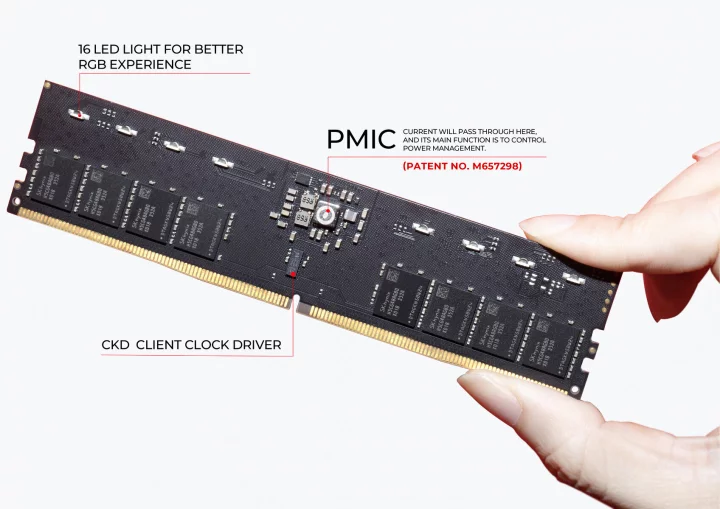One of the interesting novelties of the Core Ultra 200S desktop processors on the new Intel LGA 1851 platform is that they are the first PC processors to officially support DDR5-6400 memory, i.e. with an effective speed of 6400 MT/s (or “6400 MHz”). However, it seems that it is not so simple with it, and DDR5-6400 speed is not actually supported in all circumstances. More detailed documents show that processors guarantee it only with special modules.
According to Intel documents posted by Harukaze5719 on Twitter, Arrow Lake actually only supports DDR5-5600 when using common memory modules, called UDIMMs (unregistered DIMMs). Additionally, this specification is only guaranteed to operate one module per channel.
So why does Intel announce DDR5-6400 support in the public processor parameters? Arrow Lake only supports this speed under the condition that CUDIMM modules with an integrated clock generator are used. We originally thought that this technology would be used mainly to achieve extreme frequencies (such as DDR5-8000 to 9000) with overclocked modules. However, after revealing the Core Ultra 200S processors, for example, Micron announced CUDIMM modules with DDR5-6400 speeds. The existence of such modules makes sense now.
So Intel seems to be using CUDIMM technology as a tool to achieve support for DDR5-6400 memory according to JEDEC specifications (that is, even with a voltage of 1.1 V), not just for overclocked modules with XMP and increased voltage. This apparently means that without the help of CUDIMM modules (that is, on regular UDIMM modules), the DDR5-6400 frequency could not be fully validated on Arrow Lake processors. Official DDR5-5600 support with UDIMMs is the same speed that Raptor Lake processors already support.
It depends on how many slots the board has (even empty ones)
But it seems that DDR5-6400 is also officially supported (even if you have CUDIMMs) only when using a board with a single slot per channel (ie a board with two slots, not four). So the speed is not limited purely by the number of installed modules, but directly by the presence of slots on the board, because two slots per channel even when operating with only one module impairs the ability to reach higher clocks, as we mentioned here (this limitation also applies to Raptor Lake, too its officially supported DDR5-5600 memory frequencies are said to only apply to dual-slot boards).
In four-slot boards (which most people probably prefer), Arrow Lake CPUs officially support DDR5-5600 speeds, and this applies to both CUDIMMs and UDIMMs, as long as only half of the modules are installed. Intel has a separate official memory specification for actual deployment of two modules per channel (that is, four modules). In this case, only DDR5-4800 speed is supported if the modules are single-rank. With dual-rank modules, only DDR5-4400 is officially supported.
Is official support important?
However, it must be said that all of this applies to so-called JEDEC support, i.e. memories running entirely according to the JEDEC standard with the prescribed timing and voltage (1.1 V). JEDEC memory settings are usually used by large OEMs off-the-shelf, unless they are more powerful gaming computers. But if you have a classic assembled PC, then you usually don’t do this and use overclocked modules. Those instead of conservative JEDEC settings have increased frequencies and more aggressive timing, which is implemented on the board using XMP or EXPO profiles. These modules are essentially overclocked straight from the factory and achieve higher than JEDEC speeds also due to the fact that they tend to have an increased voltage (for example up to 1.35 V).
Modules overclocked in this way via XMP profiles to some JEDEC specifications and officially supported memory speeds given for the processor do not look at all and will happily run at DDR5-6400. Even on the previous generation of Raptor Lake processors and without an integrated clock generator (CUDIMM).
For users of gaming PCs, these snags with official DDR5-6400 support will probably not be a problem for the most part, since you will be using some modules that run overclocked using XMP profiles anyway.
But it’s interesting that in the end DDR5-6400 support is conditional in this way, because it means that the memory controller in Arrow Lake is a little less advanced than thought. But maybe it makes sense, because the SoC chiplet was probably originally developed for the intended Meteor Lake desktop processors, and it’s already a bit older. And Meteor Lake in notebooks is also not yet capable of DDR5-6400, DDR5-5600 was officially supported for these processors.
Resources: Harukaze5719, Tom’s Hardware
Source: www.cnews.cz



